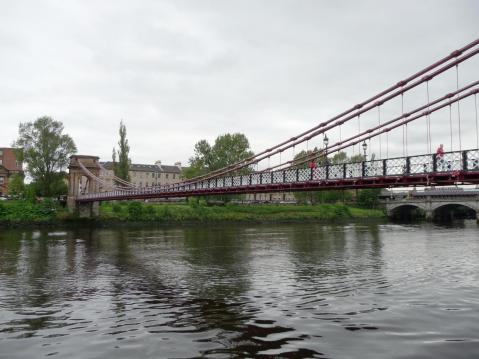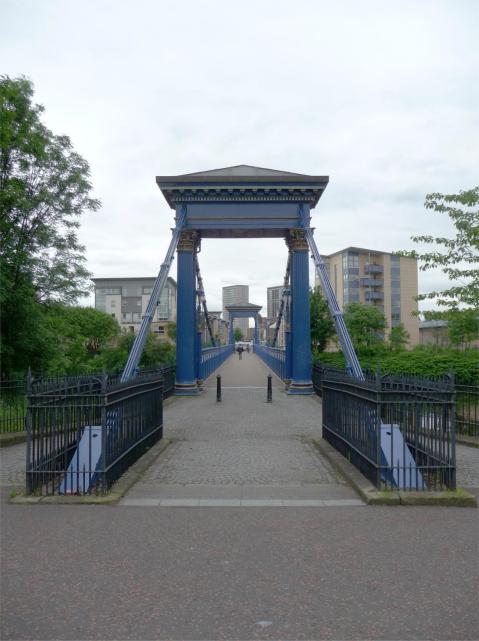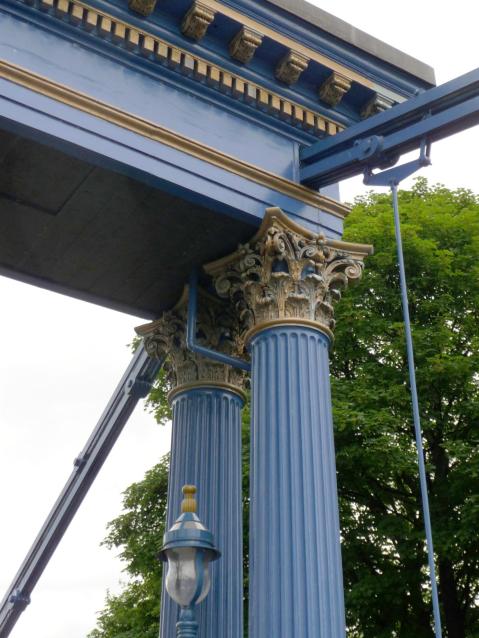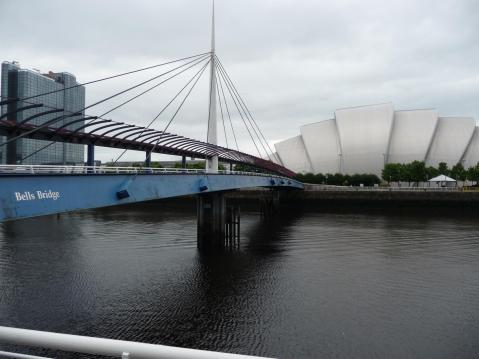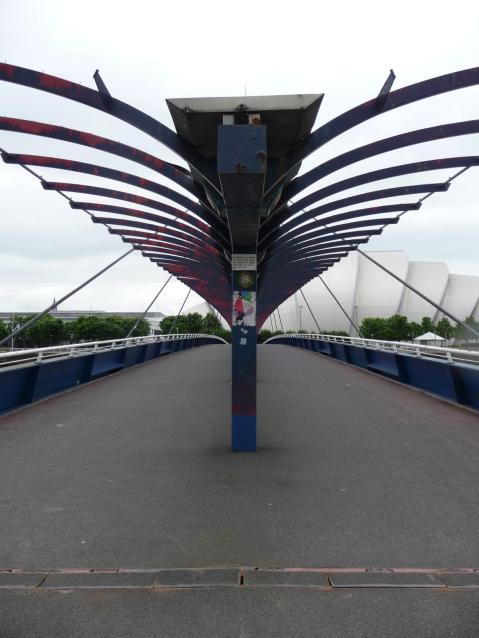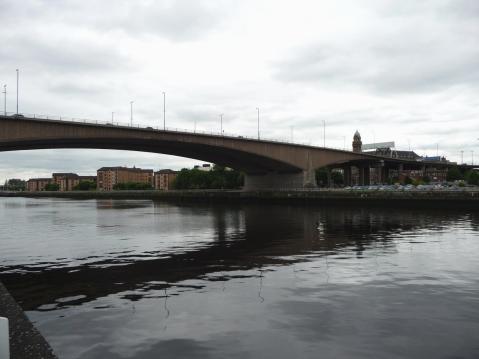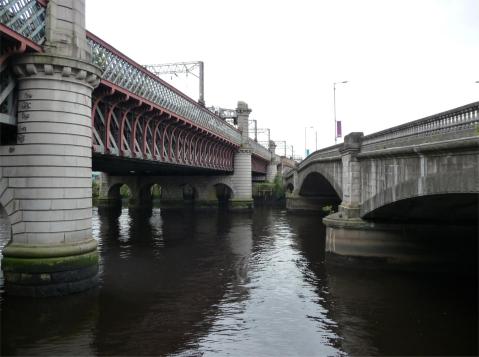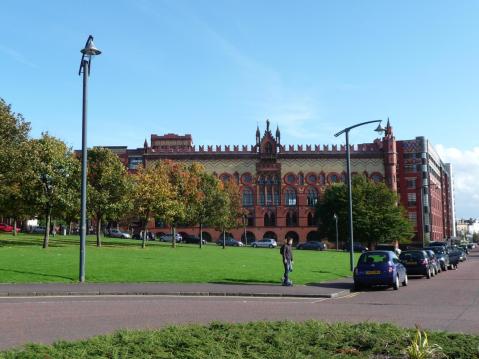Glasgow Bridges (Part 2 of 2)
The original Glasgow Bridge (or Jamaica Bridge) was completed in 1772. It was replaced in 1833 with a design by Thomas Telford, the 1st President of the Institute of Civil Engineers. It was also the 1st bridge in Glasgow to be lit by electricity. The bridge was widened and the arches enlarged at the end of the 19th Century.
Begun in 1851, the original stone tower on the South side of the South Portland Street Suspension Bridge split vertically resulting in considerable rebuilding. The arch towers are still standing today unlike the suspended decking, hangers, chains etc, which have been replaced a number of times, most recently 1926 and 2004.
Victoria Bridge was completed in 1854 and replaced the 500 year old Bishop’s Bridge due to it being too restrictive for Glasgow’s growing population. It is built on the site of the 1st recorded bridge over the River Clyde (1285) and is Glasgow’s oldest surviving complete bridge.
Built to increase capacity into the north of the city, the City Union Railway Bridge (1899) carried 4 extra tracks into the St Enoch station. It has red sandstone towers and was the 1st permanent Clyde Bridge to be built using a steel superstructure. At the time of construction it was built underneath the existing bridge to allow rail traffic to continue using the lines. The St Enoch Station was closed during the 1966 Beeching Cuts and now the line is only used for freight, charters and transportation for rail maintenance.
The current Albert Bridge is the 5th bridge on this site. It was opened to traffic in 1871. Traditional masonry construction was dismissed in favour of wrought iron arches, the largest spanning 114 feet. It is decorated with various coats of arms including Prince Albert, other Royalty and various corporate bodies. Sadly, nowadays it doesn’t befit it’s Royal connections and is in need of refurbishment.
The Tidal Weir built in 1901, suffered a failure of the foundations and collapsed in 1941. The current steel pipe bridge was completed in 1949 and carries large diameter service pipes across the river.
The main purpose of the weir is to prevent erosion to the banks of the river upstream, otherwise silt washed downstream would need to be regularly dredged. The weir marks the boundary of fresh and salt water and creates 2 different eco-systems supporting a wide range of wildlife. The upstream side is also home to the Glasgow Rowing Club.
The final bridge I shall look at is the St Andrew’s Suspension Bridge. This largely iron bridge was completed in 1856 and was built as a safer replacement for the ferry service used by many factory workers in the area.
Various aspects of the bridge have been replaced over the years and the 20ft (6m) high Corinthian columns and other ornamental features were refurbished in 1997. It is a good viewing point to watch the rowers from the clubs based at Glasgow Green.
Glasgow Bridges (Part 1 of 2)
The River Clyde has been a dominant part in the life of Glasgow and it’s bridges have played an ever more important role in the fortunes of the city. From the earliest recorded bridge in 1285 to the most recent in 2009 these crossings have been pivotal in both social and economic capacities.
Travelling from West to East the 1st bridge we see is the Millennium Bridge.
Built in 2002 as part of the Glasgow Science Centre project to improve links between both sides of the river.
The centre 2 elements of the bridge can be raised to allow the passage of larger vessels. This apparently only requires the same amount of energy as is needed to power a 100 watt lamp. In the background is the Glasgow Science Centre and the Glasgow Tower. The Tower is capable of rotating 360 degrees with the wind but has been beset by many serious problems since it opened. It is currently closed (June 13th 2012).
Next is the Bell’s Bridge. Construction of the bridge, sponsored by Bell’s & Son whisky company, was completed in 1988 with the aim of connecting the site of the International Garden Festival and the S.E.C.C.
The bridge is in 2 sections. The North side is fixed and the South side, the part with the pointed column and support cables rotates 90 degrees to create 2 lanes allowing for large vessels to pass.
One of the most recent bridges on the Clyde is the Clyde Arc. This is fondly known locally as the “Squinty Bridge” due to the fact that it is curved and is built at an angle across the river, which is caused by the location of suitable landing points on the banks.
Probably the most dominant bridge in Glasgow is the Kingston Bridge. It’s also probably the most important given that it carries approximately 150,000 vehicles every day along the M8 motorway through the centre of Glasgow. It is the largest urban bridge in the UK. It was completed in 1970 after 3 years of construction. Due to the heavy use it was strengthened in recent years. The whole bridge was jacked up and moved a distance of 50mm (2 inches). It doesn’t sound much but you must consider that the bridge weighs 52,000 tonnes!!!
The mural on the North support of the bridge, commissioned as part of the Clean Glasgow Campaign, was painted by Australian artist Sam Bates to commemorate the 2014 Glasgow Commonwealth Games. It has been specially treated and is hoped to last for up to 100 years.
The newest bridge in the city is the Tradeston Footbridge in the area of the International Financial Services District. Another bridge with a fun nickname (the Squiggly Bridge) due to it’s curves, it was opened in 2009. The triangular steel ‘fins’ are actually the main support structure which enables the bridge deck to be thinner.
Originally planned for construction in 1914, the George the Fifth Bridge (George V Bridge) was delayed by the onset of World War 1 and was eventually completed in 1928.
Right next to the George V Bridge is the main railway crossing into Glasgow Central Station. This is the 2nd Caledonian Railway Bridge. Due to competition from rival rail companies and the need for development the Caledonian Railway Company built their second bridge across the Clyde in 1905 and was built next to the original bridge.
The Caledonian Railway line originally stopped just south of the river. Then, to compete with the Clyde Union Railway Company who had already crossed the river upstream they built the 1st Caledonian Railway Bridge. The bridge was completed in 1878 and carried 4 tracks across the river. Sadly, the granite piers are all that is left of the original bridge, the rest having been dismantled in the late 1960’s.

The remaining granite piers of the 1st Caledonian Railway Bridge next to the current 2nd Caledonian Railway Bridge
On the granite piers there is an inscription carved by the poet Ian Hamilton Finlay and his collaborators, in Greek and English, a translated quote from Plato’s The Republic which, in English, reads “All greatness stands firm in the storm”.
Around Glasgow Green
Glasgow Green is a park in Glasgow’s East End on the north side of the River Clyde. It is the oldest park in Glasgow dating back to the mid 15th century. Starting out as an area for grazing, cleaning and drying fishing nets it is now very much a recreational park and is home to the People’s Palace museum and Winter Gardens.
The People’s Palace, opened in 1898 was intended to bring culture to the people of Glasgow. It originally included reading and recreation rooms, a museum and an art gallery over it’s 3 floors. It is now a museum depicting the changing social aspects of the City over the years. Adjoining the People’s Palace are the Winter Gardens, an impressive glass structure you must agree, where you can sit amongst the tropical plants and enjoy a drink and a bite to eat.
At the front of the People’s Palace is the, now refurbished and relocated, Doulton Fountain. This was gifted to the City by Sir Henry Doulton (of Royal Doulton fame) and was part of the Empire Exhibition of 1888 in Kelvingrove Park before being moved to Glasgow Green 2 years later. It is the largest terracotta fountain in the world and after it’s £4million refurbishment is one of the best quality too. It has 5 tiers, is 46 feet in height and 70 feet across.
The Templeton Carpet Factory was completed in 1892, but only after tragedy struck. In 1889, during construction of the newer part of the building a wall collapsed trapping 100 female weavers. Sadly 29 were killed. John Templeton of Paisley had patented a method of producing luxurious axminster carpetting which was used in many grand houses and even on the Titanic. The enamel tiles, glazed bricks and terracotta were designed to imitate the patterns of the carpets which the company produced. It also pleased the affluent neighbours who didn’t like the idea of living near a factory. Nowadays it has mixed usage from business to residential.
Finally we have the Nelson Monument. This was the 1st large monument erected in Britain in Nelson’s honour, just a year after his death in the Battle of Trafalgar (1805). Panels around the base of the monument record his naval victories in Aboukir, Copenhagen and Trafalgar. Damage can still be seen from a lightning strike in 1810 in which it lost about 6metres (20 feet). It is 43.5 metres (144 feet) high.




